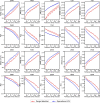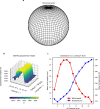Accurate medium-range global weather forecasting with 3D neural networks
- PMID: 37407823
- PMCID: PMC10356604
- DOI: 10.1038/s41586-023-06185-3
Accurate medium-range global weather forecasting with 3D neural networks
Erratum in
-
Author Correction: Accurate medium-range global weather forecasting with 3D neural networks.Nature. 2023 Sep;621(7980):E45. doi: 10.1038/s41586-023-06545-z. Nature. 2023. PMID: 37710039 Free PMC article. No abstract available.
Abstract
Weather forecasting is important for science and society. At present, the most accurate forecast system is the numerical weather prediction (NWP) method, which represents atmospheric states as discretized grids and numerically solves partial differential equations that describe the transition between those states1. However, this procedure is computationally expensive. Recently, artificial-intelligence-based methods2 have shown potential in accelerating weather forecasting by orders of magnitude, but the forecast accuracy is still significantly lower than that of NWP methods. Here we introduce an artificial-intelligence-based method for accurate, medium-range global weather forecasting. We show that three-dimensional deep networks equipped with Earth-specific priors are effective at dealing with complex patterns in weather data, and that a hierarchical temporal aggregation strategy reduces accumulation errors in medium-range forecasting. Trained on 39 years of global data, our program, Pangu-Weather, obtains stronger deterministic forecast results on reanalysis data in all tested variables when compared with the world's best NWP system, the operational integrated forecasting system of the European Centre for Medium-Range Weather Forecasts (ECMWF)3. Our method also works well with extreme weather forecasts and ensemble forecasts. When initialized with reanalysis data, the accuracy of tracking tropical cyclones is also higher than that of ECMWF-HRES.
© 2023. The Author(s).
Conflict of interest statement
K.B., L.X., H.Z., X.C., X.G. and Q.T. are employees of Huawei Cloud. A provisional patent (not granted an ID yet) was filed covering the generative algorithm described in this paper, listing the authors K.B., L.X. and Q.T. as inventors.
Figures













References
-
- Pathak, J. et al. FourCastNet: a global data-driven high-resolution weather model using adaptive Fourier neural operators. Preprint at https://arxiv.org/abs/2202.11214 (2022).
-
- Bougeault P, et al. The THORPEX interactive grand global ensemble. Bull. Am. Meteorol. Soc. 2010;91:1059–1072. doi: 10.1175/2010BAMS2853.1. - DOI
-
- Skamarock, W. C. et al. A Description of the Advanced Research WRF Version 2 (National Center For Atmospheric Research Mesoscale and Microscale Meteorology Division, 2005).
-
- Molteni F, Buizza R, Palmer TN, Petroliagis T. The ECMWF ensemble prediction system: methodology and validation. Q. J. R. Meteorol. Soc. 1996;122:73–119. doi: 10.1002/qj.49712252905. - DOI
LinkOut - more resources
Full Text Sources
Other Literature Sources

